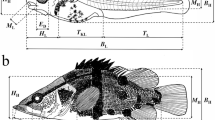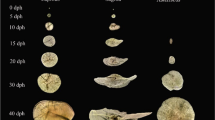Abstract
Larvae and juveniles of Coilia ectenes were collected in the Yangtze Estuary during June through September 2009 and in May 2011. Our objectives were to reveal the otolith microstructural pattern, and then to reveal the early growth and development process through otolith analysis for C. ectenes. A total of 368 individuals, ranging 4.4–81.2 mm body length (BL) and spanning a continuum from yolk-sac larvae to early juveniles, were analyzed. There is a single primordium in the core of the sagittal otolith, surrounded by a prominent dark band (PD-band) and a wide light area (WL-area). Regular bipartite increments deposit outside of the WL-area. Similar to other Engraulidae species, the PD-band forms corresponding to hatching, increments form daily, and the first increment forms on the 3rd day post hatching, corresponding to the first feeding. The relationship of otolith radius and BL was significantly fitted to a piecewise regression with the inflection point at 34.0 mm BL. Mid-age and mid-size of transition from yolk-sac to preflexion was calculated as 5 days and 6.1 mm BL, from preflexion to flexion was 18 days and 15.2 mm BL, and from flexion to postflexion 29 days and 21.5 mm BL. Mid-size from postflexion to juvenile was 26.6 mm BL. These results can provide an essential basis for future studies on early-life ecology of this species.









Similar content being viewed by others
References
Leggett GP, Deblois E (1994) Recruitment in marine fishes—is it regulated by starvation and predation in the egg and larval stages? Neth J Sea Res 32:119–224
Chambers RC, Trippel EA (1997) Early life history and recruitment in fish populations. Chapman and Hall, London
Houde ED (2002) Mortality. In: Fuiman LA, Werner WG (eds) Fishery science: the unique contributions of early life stage. Blackwell publishing, Oxford, pp 64–87
Hare JA, Cowen BK (1997) Size, growth, development and survival of the planktonic larvae of Pomatomus saltatrix (Pisces: Pomatomidae). Ecology 78:2415–2431
Bergenius MAJ, Meekan MG, Robertson DE, McCormik MI (2002) Larval growth predicts the recruitment success of a coral reef fish. Oecologia 13:521–525
Takahashi M, Watanabe Y (2004) Developmental and growth rates of Japanese anchovy Engraulis japonicas during metamorphosis in the Kuroshio-Oyashio transitional waters. Mar Ecol Prog Ser 282:253–260
Mesa ML, Donato F, Giannetti G, Arneri E (2009) Growth and mortality rates of European anchovy (Engraulis encrasicolus) in the Adriatic Sea during the transition from larval to juvenile stages. Fish Res 96:275–280
Gartner JV Jr (1991) Life histories of three species of lanternfishes (Pisces: Myctophidae) from the eastern Gulf of Mexico. Mar Biol 111:11–20
Sponaugle S (2009) Daily otolith increments in the early stages of tropical fish. In: Green BS et al (eds) Tropical fish otoliths: information for assessment, management and ecology, reviews: methods and technologies in fish biology and fisheries. Springer, Tokyo, pp 93–130
Fontes J, Santos RS, Afonso P, Caselle J (2011) Larval growth, size, stage duration and recruitment success of a temperate reef fish. J Sea Res 65:1–7
Stevenson DK, Campana SE (1992) Otolith microstructure examination and analysis. Can Spec Publ Fish Aquat Sci 117:1–126
Rogers JS, Hare JA, Lindquist DG (2001) Otolith record of age, growth, and ontogeny in larval and pelagic juvenile Stenphanolepis hispidus (Pisces: Monacanthidae). Mar Biol 138:945–953
Xie S, Watanabe Y, Saruwatari T, Masuda R, Yamashita Y, Sassa C, Konishi Y (2005) Growth and morphological development of sagittal otoliths of larval and early juvenile Trachurus japonicas. J Fish Biol 66:1704–1719
Baumann H, Pepin P, Davidson F, Mowbray F, Schnack D, Dower JF (2003) Reconstruction of environmental histories to investigate patterns of larval radiated shanny (Ulvaria subbifurcata) growth and selective survival in a large bay of Newfoundland. ICES J Mar Sci 60:243–258
Sponaugle S, Grorud-Colvert K, Pinkard D (2006) Temperature-mediated variation in early life history traits and recruitment success of the coral reef fish Thalassoma bifasciatum in the Florida Keys. Mar Ecol Prog Ser 308:1–15
Miller BS, Kendall AW (2009) Early life history of marine fishes. University of California Press, California
Dou SZ, Yokouchi K, Yu X, Cao L, Kuroke M, Otake T, Tsukamoto K (2012) The migratory history of anadromous and non-anadromous tapertail anchovy Coilia nasus in the Yangtze River Estuary revealed by the otolith Sr:Ca ratio. Environ Biol Fish 95:481–490
Shi D, Gong D (2003) Strategies of resource conservation for Coilia ectenes in the Yangtze Estuary. Mar Sci 25:96–97 (in Chinese)
Zhu D (1992) Observations and studies on embryonic development and natural reproduction of Coilia nasus. Fish Sci Technol Info 19:49–51 (in Chinese)
Xu G, Tang X, Zhang C, Gu R, Zheng J, Xu P, Le G (2011) First studies of embryonic and larval development of Coilia nasus (Engraulidae) under controlled conditions. Aquac Res 42:593–601
Zhang D, Li L, Zhong J, Ge K, Wu M, Jiang R (2009) Morphological study on larvae and juvenile of Coilia nasus in the surf zone of Yangtze river estuary. J Shanghai Ocean Univ 18:150–154 (in Chinese with English abstract)
Tsuji S, Aoyama T (1984) Daily growth increments in otoliths of Japanese anchovy larvae Engraulis japonica. Nippon Suisan Gakkaishi 50:1105–1108
Leak JC, Houde ED (1987) Cohort growth and survival of bay anchovy Anchoa mitchilli larvae in Biscayne Bay, Florida. Mar Ecol Prog Ser 37:109–122
Zhuang P, Wang Y, Li S, Deng S, Li C, Ni Y (2006) Fishes of the Yangtze Estuary. Shanghai Scientific and Technical Publishers, Shanghai (in Chinese)
Chai C, Yu Z, Song X, Cao X (2006) The status and characteristics of eutrophication in the Yangtze River (Changjiang) Estuary and the adjacent East China Sea, China. Hydrobiologia 563:313–328
Kong Y, He S, Ding P, Hu K (2004) Characteristics of temporal and spatial variation of salinity and their indicating significance in the Changjiang Estuary. Acta Oceanol Sin 26:9–18 (in Chinese with English abstract)
Li Y, Xie S, Li Z, Gong W, He W (2007) Gonad development of an anadromous fish Coilia ectenes (Engraulidae) in lower reach of Yangtze River, China. Fish Sci 73:1224–1230
He W, Li Y, Liu M, Radhakrishnan KV, Li Z, Murphy BR, Xie S (2011) Reproductive biology of Coilia mystus (Linnaenus) from the Yangtze Estuary, China: responses to overexploitation. J Appl Ichthyol 27:1197–1202
Chen Z, Wei S (1986) Morphological characteristics of Coilia grayii and Coilia mystus larvae and juveniles in the Zhujiang Estuary. Trans Chin Ichthyol Soc 5:101–108 (in Chinese)
He W, Cheng F, Li Y, Liu M, Li Z, Xie S (2011) Molecular identification of Coilia ectenes and Coilia mystus and its application on larval species. Acta Hydrobiol Sin 35:571–765 (in Chinese with English abstract)
Tomás J, Panfili J (2000) Otolith microstructure examination and growth patterns of Vinciguerria nimbaria (Photichthyidae) in the tropical Atlantic Ocean. Fish Res 46:131–145
Cermeño P, Uriarte A, Morales-nin B, Cotano U, Álvarez P (2008) Setting up interpretation criteria for ageing juvenile European anchovy otoliths. Sci Mar 72:733–742
Leonarduzzi E, Brown, Sánchez RP (2010) Seasonal variation in the growth of anchovy larvae (Engraulis anchotia) on the Argentine coastal shelf. Sci Mar 74:267–274
Hernandez EH, Castro LR (2000) Larval growth of the anchoveta Engraulis ringens during the winter spawning season off central Chile. Fish Bull 98:710–740
Radtke RL, Fey DP, Decicco AF, Montgomery A (1996) Otolith microstructure in young-of-the-year dolly varden, Salvelinus malma, from American and Asian populations: resolution of comparative life history characteristics. Aritic 49:162–169
Correia AT, Antunes C, Isidro EJ, Coimbra (2003) Changes in otolith microstructure and microchemistry during larval development of the European conger eel (Conger conger). Mar Biol 142:777–789
Hoedt FE (2002) Growth in eight species of tropical anchovy determined from primary otolith increments. Mar Freshw Res 53:859–867
Somarakisv S, Nikolioudakid N (2007) Oceanographic habitat, growth and mortality of larval anchovy (Engraulis encrasicolus) in the northern Aegean Sea (eastern Mediterranean). Mar Biol 152:1143–1158
Acknowledgments
This research was financially supported by the National Basic Research Program of China (973 Program, No. 2010CB429005), Key Laboratory of Aquatic Biodiversity and Conservation of Chinese Academy of Sciences (No. Y12Z08), State Key Laboratory of Freshwater Ecology and Biotechnology (No. 2012FB05), National Natural Science Foundation of China (No. 30771642, No. 51209202), Special Funded Project of China Postdoctoral Science Foundation (No. 2013T60764), Key Laboratory of East China Sea & Oceanic Fishery Resources Exploitation and Utilization, Ministry of Agriculture, P.R. China (No. K201205), Ministry of Water Resources Special Research Fund for Scientific Research on Public Industry ( No. 201201028-02). Participation of B. R. Murphy was facilitated by funding from the Acorn-Alcinda Foundation, Lewes, DE, USA.
Author information
Authors and Affiliations
Corresponding author
Rights and permissions
About this article
Cite this article
Huang, Y., Cheng, F., Murphy, B.R. et al. Sagittal otolith microstructure, early growth and development of Coilia ectenes in the Yangtze Estuary, China. Fish Sci 80, 435–443 (2014). https://doi.org/10.1007/s12562-014-0701-6
Received:
Accepted:
Published:
Issue Date:
DOI: https://doi.org/10.1007/s12562-014-0701-6




